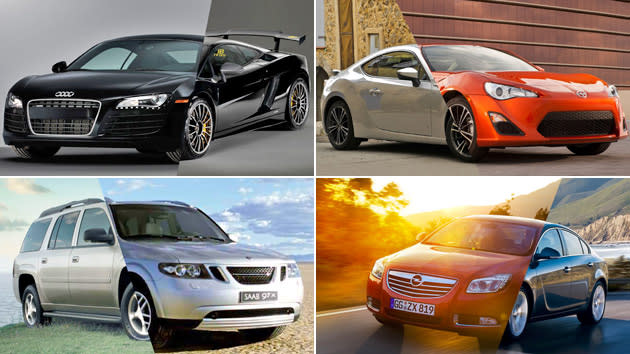10 pairs of cars separated at birth

MORE AT POPULAR MECHANICS
Lots of cars share components. But for these ostensibly different cars, the differences are only skin-deep. Born out of platform-sharing partnerships or badgineering, underneath the sheet metal these 10 pairs of cars are alike.

Subaru BRZ / Scion FR-S
The most hyped twins today are the new sport coupes built through the collaboration of Subaru and Toyota. You have to study these cars closely to find anything but a name badge to tell them apart: Their front bumper covers are slightly different, and the Scion's got a little badge that says "86" on the front fenders (a nod to the AE86 rear-drive, ultrafun Toyota Corolla coupe of 1983 to 1987). Inside, the auxiliary gauges are slightly different sizes, but the cars share a unique flatter version of Subaru's 2.0-liter flat-four engine that makes 200 hp with Toyota's fuel-injection system.
Actually, this one is a three-part rebadging job. Overseas, the Scion is called the Toyota GT-86, or just Toyota 86.

Pontiac Vibe / Toyota Matrix
The sheet metal on these two tall compact wagons is slightly different, as are the plastic fascias, but the biggest difference is that these mostly identical cars were built at different factories. The Pontiac was built in Fremont, Calif., from 2003 until GM announced it was killing Pontiac and stopped Vibe production in 2009. Matrix production continues at Toyota's Ontario, Canada, plant. Additionally, for a couple of years Toyota sold the Vibe in Japan and called it the Voltz.

Honda Odyssey / Isuzu Oasis
Today's Honda minivan follows convention: sliding rear doors and massive interior space. But when the Odyssey was introduced in 1994, it was basically a tall Accord sedan with four swing-open doors, though with three rows and a six-passenger capacity.
At the time, truck-based SUVs were all the rage, and Honda didn't have a truck. To get one, Honda traded its minivan to Isuzu in 1996, creating the best minivan bargain North American consumers have ever seen: Low-status Isuzu badged the first-generation Odyssey as the Oasis, which sold for about $2000 less than the Honda version of the same minivan. Isuzu sold the Oasis until 1999.

Honda Passport / Isuzu Rodeo
This one goes all the way back to 1972, when GM's "captive import" Isuzu truck company in Japan produced a compact pickup sold here as the Chevy LUV truck. When compact-truck-based SUVs boomed in the 1990s, Honda made a deal to sell Isuzu's compact-truck-based Rodeo SUV as the Honda Passport, complete with a General Motors' pushrod V-6 engine. The Isuzu Rodeo and Honda Passport were identical but for badges, though Honda dropped the Passport in 2002 due to low sales. The automaker didn't get a true SUV until the Acura MDX of 2001 and the Pilot of 2003, both of which are actually based on the Odyssey minivan, not on a truck.

 Yahoo Autos
Yahoo Autos 
